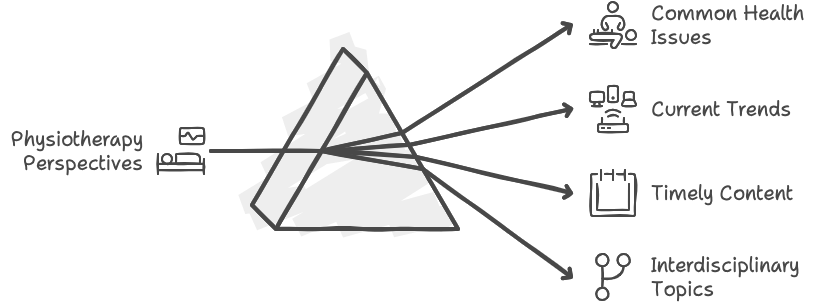As a practising physiotherapist with over 15 years of experience and a PhD in Physical Therapy, I’ve learned that creating an influential blog is like developing a personalized treatment plan. It requires a deep understanding of your audience, careful planning, and consistent effort. In this guide, I’ll share evidence-based strategies to help you create a physiotherapy blog that engages your readers and establishes you as a trusted authority in the field.
Understanding Your Blogging Audience

Just as a thorough patient assessment is crucial for effective treatment, understanding your blog audience is fundamental to creating resonating content. Here’s how to develop a clear picture of your readers:
- Analyze demographic data: Use tools like Google Analytics to gather information about your readers’ age, location, and interests.
- Conduct surveys: Regularly ask your patients and readers about their content preferences and pain points.
- Monitor engagement metrics: Pay attention to which posts generate the most comments, shares, and time spent on the page.
Tailoring your content to your audience’s needs and preferences will create a more engaging and valuable resource.
Topic Selection for Physiotherapy Blogs
Choosing the right topics is crucial for maintaining relevance and authority. Based on my clinical experience and research, here are some practical approaches:
- Address common health issues: Focus on conditions you frequently treat, such as lower back pain, which affects up to 80% of adults at some point (source: National Institute of Neurological Disorders and Stroke).
- Stay current with physiotherapy trends: Discuss emerging techniques and technologies. For example, the growing field of telerehabilitation has shown promising results in recent studies (source: Journal of Telemedicine and Telecare, 2023).
- Provide seasonal and timely content: Align your posts with current events or seasons. For instance, during colder months, offer winter sports injury prevention tips.
- Explore interdisciplinary topics: Discuss how physiotherapy integrates with other health disciplines, such as nutrition or mental health, to provide a holistic view of patient care.

Crafting Engaging and Informative Content

Creating content that captivates and educates your audience requires a blend of scientific accuracy and storytelling. Here’s how to achieve this balance:
- Share patient success stories: Use anonymized case studies to illustrate the effectiveness of specific treatments. Ensure you have proper consent and follow HIPAA guidelines.
- Provide actionable advice: Offer step-by-step guides for home exercises or pain management techniques backed by peer-reviewed research.
- Incorporate expert opinions: Feature interviews with other healthcare professionals to provide diverse perspectives and enhance credibility.
- Use visuals effectively: To explain complex concepts, include diagrams, infographics, or videos. For example, a video demonstrating the proper form for a rehabilitation exercise can be more effective than text alone.
Remember, you aim to empower readers with knowledge while showcasing your expertise.
SEO Strategies for Physiotherapy Blogs
Optimizing your blog for search engines is crucial for reaching a wider audience. Here are some evidence-based SEO tactics specifically for physiotherapy blogs:
- Keyword research: Use tools like Google Keyword Planner to identify terms potential patients are searching for, such as “sciatica exercises” or “rotator cuff rehabilitation.”
- Optimize meta descriptions and titles: Craft compelling, keyword-rich titles and descriptions to improve click-through rates from search results.
- Create pillar content: Develop comprehensive guides on core physiotherapy topics, which can serve as authoritative resources and attract backlinks.
- Implement structured data: Use schema markup to help search engines understand your content better, potentially leading to rich snippets in search results.
Promoting Your Physiotherapy Blog Effectively
Promoting your blog is essential for building an audience and establishing authority. Based on my experience and industry best practices, here are some effective strategies:
- Leverage social media: Share your posts on LinkedIn, Twitter, and Facebook platforms. Engage with your followers and participate in relevant online communities.
- Email marketing: Build a subscriber list and send regular newsletters featuring your latest blog posts and exclusive content.
- Collaborate with other professionals: Guest post on other reputable health and wellness blogs and invite other experts to contribute to your blog.
- Participate in professional events: Present at conferences or local health fairs, and use these opportunities to promote your blog and expertise.
Measuring Success and Continuous Improvement
To ensure your blog’s ongoing success, it’s crucial to assess its performance and make data-driven improvements regularly:
- Track key performance indicators (KPIs): Monitor metrics such as page views, time on page, bounce rate, and conversion rates.
- Conduct A/B testing: To optimise engagement, experiment with different content formats, headlines, and calls to action.
- Solicit reader feedback: Regularly ask your audience for suggestions and topic ideas to keep your content relevant and valuable.
- Stay updated with industry changes: Attend conferences, read peer-reviewed journals, and participate in continuing education to ensure your blog reflects the latest physiotherapy research and practice.
By implementing these strategies and consistently producing high-quality, evidence-based content, you’ll create a physiotherapy blog that ranks well in search engines and serves as a trusted resource for patients and fellow professionals alike. Building a successful blog takes time and dedication, but the rewards – patient education, professional recognition, and practice growth – are well worth the effort.
Frequently Asked Questions
How Do I Write a Physiotherapy Blog?
Start by identifying your target audience and their interests. Create engaging, informative content that addresses their needs, using SEO techniques to improve visibility. Stay current with physiotherapy trends and engage with your readers through social media and comments.
How Do You Write a Blog Best Practice?
Focus on delivering clear, compelling content that resonates with your audience. Implement SEO strategies to improve discoverability, craft attention-grabbing headlines, and stay up-to-date with industry developments. Leverage social media to boost your blog’s visibility and engagement.
How Do I Market Myself as a Physical Therapist?
Showcase your expertise through in-depth articles and patient success stories. Offer valuable resources like exercise guides or tutorial videos and optimize for local SEO. Engage on social media, collaborate with other health professionals, and consider hosting webinars or Q&A sessions to demonstrate your knowledge and approachability.
How Can I Effectively Promote My Physiotherapy Clinic on Instagram?
Share visually appealing content like exercise demonstrations and treatment techniques, using relevant hashtags for visibility. Educate followers with informative infographics and showcase your team to add a personal touch. Actively engage with your community, respond promptly to comments and messages, and consider collaborations or targeted ads to expand your reach.





